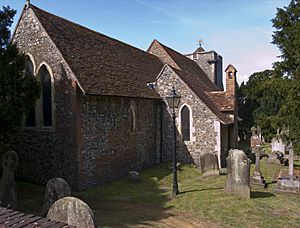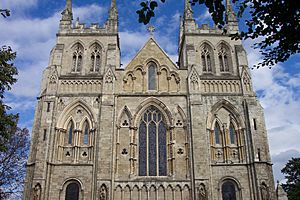Church of England parish church facts for kids

A parish church in the Church of England is like the main church for a specific local area. This area is called a parish. Think of it as the religious heart for the people living there. Since the 1800s, these church parishes are sometimes called "ecclesiastical parishes" to avoid confusion with "civil parishes," which are local government areas.
What is a Church of England Parish?
In England, you'll find parish churches for both the Church of England and the Catholic Church. However, when people just say "parish church," they usually mean one that belongs to the Church of England. This is because the Church of England is the official "Established Church" of England.
The Church of England is organized into many parishes. Each parish is also part of a larger area called a diocese. Almost every part of England belongs to both a parish and a diocese. These church parishes are often different from the civil parishes used for local government. Even big cities with cathedrals still have their own church parishes and parish churches.
Each parish has a special priest who looks after it. This priest is usually called a vicar, rector, or priest-in-charge. Most parishes have one main church that is actively used. Sometimes, if there isn't a main church, the bishop might allow another building to be used for worship. A parish might also have smaller churches called "chapels of ease."
Sometimes, you might find "redundant" parish churches. These are churches that are no longer used for regular services. This can happen if two parishes merge, or if the church is too expensive to maintain. These unused churches might become ruins, stay empty, or be used for other purposes.
History and Look of Parish Churches
Many Church of England parish churches are very old. Some were built before the 1500s, which means they existed before the big changes of the Reformation. This was a time when Western Christianity divided into different groups. Some churches even date back to the Anglo-Saxons! You can see different styles of architecture from all periods in these churches. Most parish churches have parts that are from the Middle Ages, even if they have been changed or added to later.
The parish churches in the City of London are especially famous for their Baroque style. Each church building shows its importance, and they come in many different sizes and designs. Some very large churches that used to be part of monasteries or colleges are now parish churches.
Besides their amazing architecture, many Church of England parish churches are known for their beautiful and interesting items inside. These items have often survived for hundreds of years. You might see old monuments, colorful stained glass windows, wall paintings, and special floor tiles. You can also find carved pews (church benches), choir stalls, lecterns (stands for reading), and fonts (bowls for baptisms).
In the past, the parish church was super important to every community, especially in the countryside. It was a central part of daily life. However, in recent times, fewer people attend church services. Also, there are fewer Anglican priests. Because of this, many parish churches now share priests or have services less often, sometimes not every Sunday.
Famous Parish Churches
Here are a few examples of notable Church of England parish churches:
- St Martin's Church, Canterbury, Kent: This is the oldest surviving Church of England parish church that has English origins. It's a truly historic place!
- Culbone Church, Somerset: This tiny church holds the record for being the smallest parish church in England. It's very unique!
- St Botolph's Church, Boston, Lincolnshire: Known as "The Stump," this church has a very tall and famous tower.
- St Mary Redcliffe, Bristol: This church is famous for its beautiful Perpendicular Gothic style and its many roof bosses (carved decorations).
- Beverley Minster, East Riding of Yorkshire: This is one of the largest parish churches in England. It's huge and impressive!
- St Margaret's, Westminster, London: This church is right next to the Palace of Westminster (where the British Parliament meets). It's often called the parish church of the Houses of Parliament.








